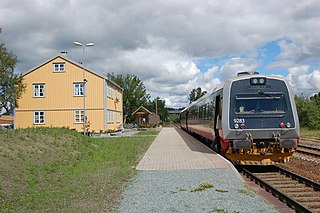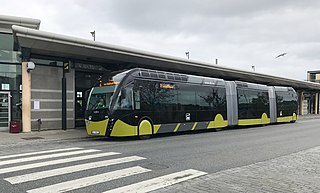
Trøndelag (Urban East Norwegian:[ˈtrœ̂ndəˌlɑːɡ]; or Trööndelage is a county and coextensive with the Trøndelag region in the central part of Norway. It was created in 1687, then named Trondhjem County ; in 1804 the county was split into Nord-Trøndelag and Sør-Trøndelag by the King of Denmark-Norway, and the counties were reunited in 2018 after a vote of the two counties in 2016.

Innherred (Bokmål) or Innherad (Nynorsk) is a traditional district in Trøndelag county in the central part of Norway. It consists of the areas around the inner part of the Trondheimsfjord in the central-east part of the county. The district includes the municipalities of Levanger, Frosta, Verdal, Inderøy, and Steinkjer. Historically, the municipalities of Snåsa and Namdalseid have sometimes also been included in the Innherred district. The area encompasses about 7,913 square kilometres (3,055 sq mi) and about 68,062 residents (2004). There are several larger towns/cities in Innherred including Steinkjer, Levanger, and Verdalsøra.

The Nordland Line is a 729-kilometer (453 mi) railway line between Trondheim and Bodø, Norway. It is the longest in Norway and lacks electrification. The route runs through the counties of Trøndelag and Nordland, carrying a combination of commuter, long-haul passenger and freight trains. From Trondheim Central Station to Steinkjer Station the line is most heavily used, with hourly services by the Trøndelag Commuter Rail. There are three branch lines—the Stavne–Leangen Line at Leangen Station, the Meråker Line at Hell Station and the Namsos Line at Grong Station.

Fosen Trafikklag is a company operating buses and ferries in Trøndelag and Østlandet in Norway. In total the company has approximately 750 vehicles and 16 ships, though numerous of them operate by subsidiaries.

Trondheim Central Station or Trondheim S is the main railway station serving the city of Trondheim, Norway. Located at Brattøra in the north part of the city centre, it is the terminus of the Dovre Line, running southwards, and the Nordland Line, which runs north. The railway is electrified south of the station but not north of it, so through trains must change locomotives at the station.

The Namsos Line is a 51-kilometer-long (32 mi) railway line between the village of Medjå and the town of Namsos in Trøndelag county, Norway. The line branches off from the Nordland Line at Grong Station and runs through Grong Municipality, Overhalla Municipality, and Namsos Municipality. The line largely follows the river Namsen. The section from Grong to Skogmo is maintained, although not used for ordinary traffic. The section from Skogmo to Namsos is closed, but the infrastructure remains.

The Trøndelag Commuter Rail is a commuter train service operating in Trøndelag county, Norway. It was operated with Class 92 diesel multiple units by Vy, until 7 June 2020, when SJ Norge took over the contract until 2030. The service provides a commuter service connecting Trondheim to its suburbs, between towns in Innherred and as an airport rail link for Trondheim Airport, Værnes. Although passenger services have operated along the lines since 1864, the commuter train was created with an increase of service with existing rolling stock in 1993. In 2019, the system was used by 1.4 million passengers.
Innherredsferja AS was a Norwegian ferry operator in the Trondheimsfjord in Nord-Trøndelag county. It operated the Levanger–Hokstad Ferry between the town of Levanger and the island of Ytterøya, and the Vangshylla–Kjerringvik Ferry between Inderøy and Mosvik. The company operated seven ferries through its history, and had up to three operating at any time, including one in reserve. Innherredsferja was based in Levanger.

Trondheim Airport Station, also known as Værnes Station, is a railway station located within the terminal complex of Trondheim Airport, Værnes in Stjørdal Municipality in Trøndelag county, Norway. Situated on the Nordland Line, it serves both express trains and the Trøndelag Commuter Rail both operated by SJ Norge. The station was opened on 15 November 1994 along with a new terminal at the airport, making it the first airport rail link in the Nordic Countries. The station cost 24 million kr, and was built along the existing railway line. In each direction, the station handles one to two hourly commuter rail services, and three daily express services. Travel time to Trondheim is 38 minutes, while it is 9 hours and 5 minutes to Bodø. Access to the airport terminal is outdoors, but sheltered.

Nord-Trøndelag University College was a Norwegian university college located throughout the county of Nord-Trøndelag. HiNT had about 5,500 students and 440 employees in 2013. In January 2016, the university was merged with Nesna University College and the University of Nordland, becoming Nord University.

Nord-Trøndelag County Municipality was the regional governing administration of the old Nord-Trøndelag county in Norway. The county municipality was established in its current form on 1 January 1976 when the law was changed to allow elected county councils in Norway. The county municipality was dissolved on 1 January 2018, when Nord-Trøndelag was merged with the neighboring Sør-Trøndelag county, creating the new Trøndelag county which is led by the Trøndelag County Municipality.

The Hell–Sunnan Line is a 105-kilometer-long (65 mi) railway line between Hell and Sunnan in Trøndelag county, Norway. The name is no longer in official use and the line is now considered part of the Nordland Line. The Hell–Sunnan Line branches from the Meråker Line at Hell and runs on the east shore of the Trondheimsfjord passing through Stjørdal Municipality, Levanger Municipality, Verdal Municipality, Inderøy Municipality, and Steinkjer Municipality.
T-kort is a digital ticketing system used for travel with public transport in Trøndelag, Norway. After its implementation in 2008, T-kort became the only valid ticketing system in the area, valid on bus, coach, tram and ferry transport as well as the Trøndelag Commuter Rail. The ticket is the size of a credit card, and can be charged monthly or as individual tickets.

The Flakk–Rørvik Ferry is an automobile ferry in Trøndelag county, Norway. The line is part of Norwegian County Road 715, which connects the Fosen peninsula with the city of Trondheim. The crossing of Trondheimsfjord is performed with the two - three double-ended ferries; MF Lagatun, MF Munken, which are Hybrid Electric, and MF Trondheim and operated by FosenNamsosSjø, contracted by the Public Transport Operator of Trøndelag, AtB. The Crossing takes 25 Minutes, and has a length of 7,4 Km.

Nord-Trøndelag was a county constituting the northern part of the present-day Trøndelag county in Norway. It bordered the old Sør-Trøndelag county as well as the county of Nordland. To the west is the Norwegian Sea, and to the east is Jämtland in Sweden. The county was established in 1804 when the old Trondhjems amt was divided into two: Nordre Trondhjems amt and Søndre Trondhjems amt. In 2016, the two county councils voted to merge (back) into a single county on 1 January 2018.
A/S Stenkjær og Namsos Automobilselskap was a Norwegian bus company that operated services from Steinkjer to Namsos from 1908 to 1920, when the company was taken over by the county-owned Fylkesbilene i Nord-Trøndelag. The company operated Rex Simplex buses in addition to the ferry Oma from Rødkleiva to Namsos.

Trøndelag County Municipality is the democratically elected regional governing administration of Trøndelag county in Norway. The main responsibilities of the county municipality includes the running of 36 upper secondary schools, with 17,000 pupils. It administers thousands of kilometers of county roadways, public transport, dental care, culture, and cultural heritage.

AtB AS is a public transport manager for Trøndelag county and is managed as a corporation. AtB's task is to plan, order, market and develop public transport in the county. Tariffs are set by the county council as part of the budget process. AtB has three main sources of funding: Ticket revenues, grants from the Trøndelag County Municipality and the Environmental Package. AtB has a customer center at Prinsens Gate 41 right beside the bus stop Prinsens Gate P2 in Trondheim. AtB took over as public transport manager for bus traffic in Trondheim in 2010, tram traffic on Gråkallbanen and other bus traffic in Sør-Trøndelag county in 2011, speedboat routes in 2012 and 2014, ferries in 2015, and in 2018, the former Nord-Trøndelag county was also incorporated after the two counties was merged into the new county of Trøndelag.

Trøndelag District Court is a district court located in Trøndelag county, Norway. This court is based at four different courthouses which are located in Brekstad, Namsos, Steinkjer, and Trondheim. The court serves the entire county which includes 38 municipalities: Flatanger, Frosta, Frøya, Grong, Heim, Hitra, Holtålen, Høylandet, Inderøy, Indre Fosen, Leka, Levanger, Lierne, Malvik, Melhus, Meråker, Midtre Gauldal, Namsos, Namsskogan, Nærøysund, Oppdal, Orkland, Osen, Overhalla, Rennebu, Rindal, Røros, Røyrvik, Selbu, Skaun, Snåsa, Steinkjer, Stjørdal, Trondheim, Tydal, Verdal, Ørland, and Åfjord. The court is subordinate to the Frostating Court of Appeal.



















